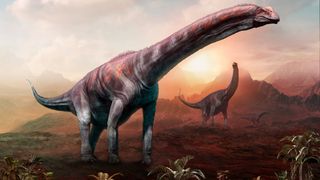
How big can animals get?
Animals, especially those on land, can't grow indefinitely. The reason has to do with the square-cube law.

The largest animal ever to walk on Earth was likely the dinosaur Argentinosaurus, a hulking 77-ton (70 metric tons) titanosaur that lived about 90 million years ago during the Late Cretaceous. For comparison, the heaviest animal on land today is the African elephant (Loxodonta), which weighs less than 7 tons (6 metric tons). And both look positively dainty next to the blue whale (Balaenoptera musculus), which, at an average of 165 tons (150 metric tons), may be the heaviest animal ever to have lived.
But could any animal ever top that? Is there a limit to how large an animal can get?
"We look at blue whales, and the question is whether we could get anything bigger," Geerat Vermeij, a professor of geobiology and paleobiology at the University of California, Davis, told Live Science. "I'm not sure I'd be willing to say no to that question. Size depends on many factors, and I take a relativistic point of view."
At least in theory, though, there may be a hard limit — enforced by the laws of physics — of about 120 tons (109 metric tons) for land animals, according to Felisa Smith, a professor of paleoecology at the University of New Mexico. "To be bigger than that, on land, your legs would have to be so wide to support your body that you couldn't efficiently walk," she told Live Science in an email.
Smith is referring to the square-cube law, a mathematical principle first described by Galileo Galilei as "the ratio of two volumes is greater than the ratio of their surfaces." In other words, as an animal increases in size, its volume will grow faster than its surface area, so larger animals need much larger limbs to support their weight. If we were to merely scale up an elephant by several orders of magnitude, the square-cube law holds that it would collapse — its mass would increase by a power of three, while its limbs would increase in size by a power of two.
Related: What is the largest squid in the world?

The only way our imaginary mega-elephant could overcome this limitation would be to have disproportionately large and thick legs. But even then, at around the 120-ton mark, the limbs necessary to keep the mega-elephant on its feet would become improbably bulky. "The largest animals in the fossil record are just under 100 tons [90 metric tons], which supports this theoretical maximum," Smith said, adding that "it's not clear that bigger ones couldn't have evolved."
Sign up for the Live Science daily newsletter now
Get the world’s most fascinating discoveries delivered straight to your inbox.
But physics is not the only constraint on animal size. If it were, we would live in a world packed with 100-ton land animals, carefully toeing Galileo's square-cube line. Resource availability is also a significant factor — megafauna have to eat. "Animals that live in more productive environments with high quality foods are generally able to harbor larger maximum body sizes," said Jordan Okie, a quantitative biologist at Arizona State University. "Whales, elephants, and other megabiota tend to live in productive, nutrient rich environments."
Related: 10 of the best giant monster movies
Nutrient requirements also explain why reptiles, like titanosaurs, grew much larger than even the largest land mammals, according to Smith. Because warm-blooded mammals have faster metabolisms, they require about 10 times the amount of food to support a given body size than reptiles do, Smith explained. Reptiles, on the other hand, have lower body temperatures and slower metabolisms, so they can afford to eat less and can grow on a calorie budget that would starve a mammal.
"Not surprisingly, the largest dinosaurs in terrestrial areas were about 10x bigger than the largest mammals," Smith said.
Blue whales, which can weigh about 165 tons and are warm-blooded mammals, are glaring exceptions to several of these rules. But their unique environment explains their success. Marine megafauna can take advantage of their buoyancy to scale up in size without straining their muscles and bones, growing in ways that would make the limbs of land animals crumble. And whales have miles of open ocean at their disposal, which they travel to pursue meals.

"Animals in water are expected to be less limited by biomechanical constraints," Okie told Live Science in an email. "The oceans also provide abundant, nutrient-dense resources for those animals that are mobile and resourceful." In particular, the evolution of baleen plates allowed whales to consume zooplankton efficiently enough to support their enormous sizes, Okie added.
Various constraints aside, the planet can clearly support megafauna. For hundreds of millions of years, megafauna were pervasive. Yet, throughout the past 20,000 years or so, a mere blink in evolutionary time, megafauna have all but vanished. Large land mammals such as elephants and rhinos are in decline, existing in only specific parts of the world; several groups of marine megafauna, such as whales, are perpetually tottering on the brink of extinction. So where did all of the giants go?
"Humans eliminated most of them," Vermeij said. "Mammoths, elephants, bison, large carnivores — we've eliminated 90% of large animals, maybe more, and certainly all of the largest ones."
Humans are also the chief obstacle to the revival of these large species.
"You'd have to have no humans before megafauna could make a comeback," Vermeij said. "We're the dominant species, by far, and no animal is going to get large under our hegemony. The chances of getting anything as big as a Cretaceous dinosaur again are unlikely."

Joshua A. Krisch is a freelance science writer. He is particularly interested in biology and biomedical sciences, but he has covered technology, environmental issues, space, mathematics, and health policy, and he is interested in anything that could plausibly be defined as science. Joshua studied biology at Yeshiva University, and later completed graduate work in health sciences at Cornell University and science journalism at New York University.
-
Stephan Gunther "The largest animal ever to walk on Earth was likely the dinosaur Argentinosaurus, a hulking 77-ton (70 metric tons) titanosaur that lived about 90 million years ago during the Late Cretaceous. "Reply
""The largest animals in the fossil record are just under 100 tons , which supports this theoretical maximum,"
This is confusing. Which is it - 77 or 100 ton ?
Most Popular

